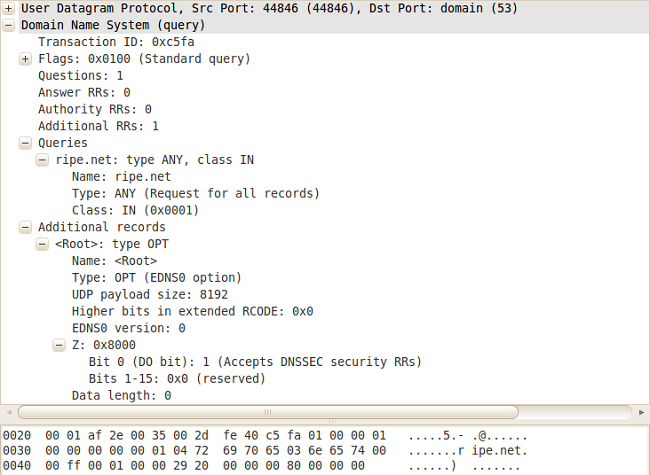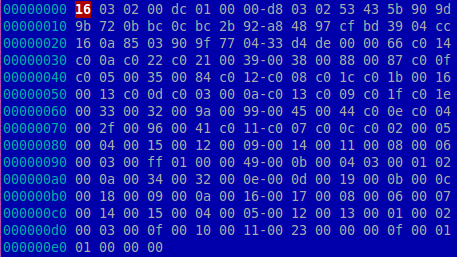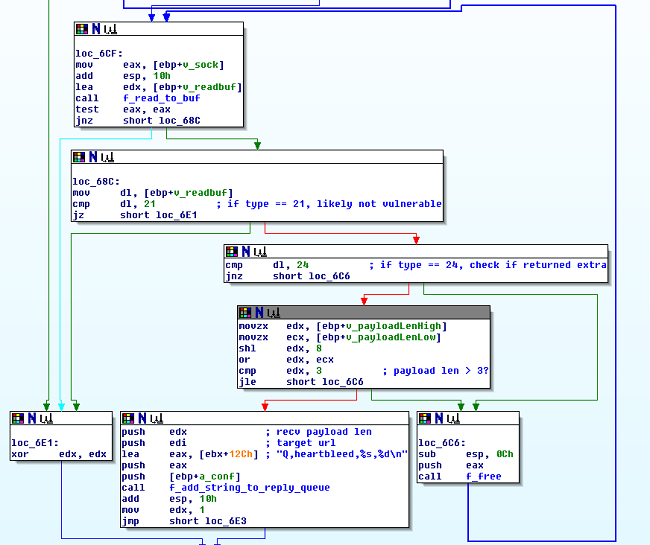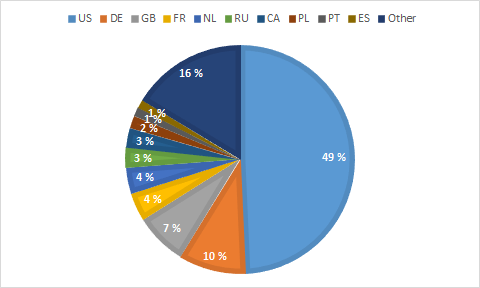Newsfeed
Nachrichtenbote
Malware targeting Linux servers has been increasingly hitting the headlines over the past year. In this post we will present research on an advanced and highly versatile malware operation targeting Linux and FreeBSD servers. We have named the malware family at the heart of this operation GalacticMayhem, as a reference to some of the C&C urls. It is the same family of malware that was written about by a team of researchers from Yandex.
Overview
Infection of a server with Mayhem begins with a PHP dropper script. This script is responsible for dropping a malicious ELF shared object file and executing it. The dropped binary is usually named libworker.so but our research has also uncovered cases where the binary was called atom-aggregator.so or rss-aggr.so. The dropper script always includes both a 32-bit and a 64-bit version of the malware. These are of identical functionality and configuration.
The dropper script first kills all running /usr/bin/host -processes. Next it checks whether the host is 32-bit or 64-bit and Linux or FreeBSD. The script then picks the correct binary for the host architecture, adjusts its ELF header to take into account the operating system and finally writes the binary to disk. The dropper also writes to disk a shell script named 1.sh. The shell script is responsible for clean up and for executing the malware. It accomplishes this using the so called 'LD_PRELOAD' -technique in which an environment variable, 'LD_PRELOAD' is set with the path to the dropped binary. Next, the executable /usr/bin/host is executed. The OS loader loads the malicious binary allowing it to hook the exit -function that will eventually get called by /usr/bin/host. Once /usr/bin/host calls exit, execution gets passed to the malicious binary.
Our research has so far uncovered 47 unique Mayhem samples. The earliest of these samples are at least half a year old, the newest possibly less than a week old. From analysing the samples, it is clear that Mayhem has gone through three major iterations during its development. Each iteration has made the malware increasingly more complex and advanced. In addition, smaller, incremental updates have been observed. This shows that the Mayhem family of malware is under active development. The rest of this post will focus on the latest and most feature-rich iteration of Mayhem.
The Mayhem malware is designed to be highly modular. It consists of a main component and multiple optionally loaded modules. The main component is responsible for communicating with the C&C as well as loading, unloading and executing the modules. The malware also uses a hidden, encrypted filesystem to store the modules themselves as well as other files used by the modules. This filesystem is stored on disk, in a file whose name is specified as part of the malware's configuration data. In most cases the file has been named .sd0. However, we have recently observed the malware author(s) switching to naming the file .caches. This is possibly in response to the name of the hidden filesystem file being published in multiple sources and being used to search for infected systems. Again, it is clear that the malware is under active development. It should be noted that the size of the hidden filesystem file is also specified in the malware configuration data and has been exactly 12MB in all the cases we have observed.
The Mayhem malware communicates with its C&C server using specially crafted HTTP post -requests. The headers of these requests are highly distinctive because they only contain 3 specific fields, the 'Host', 'Pragma' and 'Content-Length' -fields. Of these, the value of the 'Pragma' -field is always '1337'. Additionally, the HTTP version is always specified as 1.0. An example of a request from the malware to its C&C server can be seen below.

As can be seen, the actual body of the request consists of one or more lines specifying commands or messages. These lines always begin with a single character specifying the message type followed by a comma-delimited list of parameters. The supported message types enable, among others, the sending and receiving of data and files, the starting and stopping of jobs, the loading and updating of modules and reporting malware status to the C&C.
After infection and setup, the malware will attempt to send a request to the C&C server hardcoded in its configuration data. This request will contain information on the host system and the environment the malware is operating under. Once the malware receives a satisfactory reply from the C&C server, it will revert to regurlarily sending a request to the C&C server reporting its current status. If the C&C server is currently not participating in any specific activity, it will reply instructing the malware to sleep and ping back again later.
The C&C server can also reply to the malware with a new job. In this case, the C&C will first instruct the malware on a module to load as well as optionally instructing additional files for the module to load, like rule files or password lists. In this case, the malware will first search its hidden filesystem for the module specified and if found, reply to the C&C server with a CRC-32 checksum of the module. The C&C server will then reply informing the malware whether the module found is the latest version or whether the malware should request a newer version from the C&C server. If the module found is an old version or if the module is not found at all, the malware will request the module from the C&C server as base64 encoded data in a HTTP response.
Once the module has been acquired, the main component of the malware will load the module and call an entrypoint function. This entrypoint function will perform additional setup and possibly request additional files from the hidden filesystem or C&C server. This function will also register one to four callback functions to be called by the main component under specific circumstances. This is how the main functionality of the module will get executed.
After the module has been successfully loaded, the C&C server may instruct the main component to start a new job. This will result in the main component creating an operator-specified number of threads each executing the functionality of the loaded module. Finally the C&C server will begin sending argument strings to the malware for the module to process. The contents of these argument strings depend on the loaded module, but usually contain at least a target domain or URL for the malicious activity.
Modules
During our research, we have encountered, in the wild, 11 different modules used by the Mayhem malware. For most of these, we have observed multiple distinct versions. This clearly shows that also the modules are under active development.
The modules we have encountered are:
Weiterlesen...
Overview
Infection of a server with Mayhem begins with a PHP dropper script. This script is responsible for dropping a malicious ELF shared object file and executing it. The dropped binary is usually named libworker.so but our research has also uncovered cases where the binary was called atom-aggregator.so or rss-aggr.so. The dropper script always includes both a 32-bit and a 64-bit version of the malware. These are of identical functionality and configuration.
The dropper script first kills all running /usr/bin/host -processes. Next it checks whether the host is 32-bit or 64-bit and Linux or FreeBSD. The script then picks the correct binary for the host architecture, adjusts its ELF header to take into account the operating system and finally writes the binary to disk. The dropper also writes to disk a shell script named 1.sh. The shell script is responsible for clean up and for executing the malware. It accomplishes this using the so called 'LD_PRELOAD' -technique in which an environment variable, 'LD_PRELOAD' is set with the path to the dropped binary. Next, the executable /usr/bin/host is executed. The OS loader loads the malicious binary allowing it to hook the exit -function that will eventually get called by /usr/bin/host. Once /usr/bin/host calls exit, execution gets passed to the malicious binary.
Our research has so far uncovered 47 unique Mayhem samples. The earliest of these samples are at least half a year old, the newest possibly less than a week old. From analysing the samples, it is clear that Mayhem has gone through three major iterations during its development. Each iteration has made the malware increasingly more complex and advanced. In addition, smaller, incremental updates have been observed. This shows that the Mayhem family of malware is under active development. The rest of this post will focus on the latest and most feature-rich iteration of Mayhem.
The Mayhem malware is designed to be highly modular. It consists of a main component and multiple optionally loaded modules. The main component is responsible for communicating with the C&C as well as loading, unloading and executing the modules. The malware also uses a hidden, encrypted filesystem to store the modules themselves as well as other files used by the modules. This filesystem is stored on disk, in a file whose name is specified as part of the malware's configuration data. In most cases the file has been named .sd0. However, we have recently observed the malware author(s) switching to naming the file .caches. This is possibly in response to the name of the hidden filesystem file being published in multiple sources and being used to search for infected systems. Again, it is clear that the malware is under active development. It should be noted that the size of the hidden filesystem file is also specified in the malware configuration data and has been exactly 12MB in all the cases we have observed.
The Mayhem malware communicates with its C&C server using specially crafted HTTP post -requests. The headers of these requests are highly distinctive because they only contain 3 specific fields, the 'Host', 'Pragma' and 'Content-Length' -fields. Of these, the value of the 'Pragma' -field is always '1337'. Additionally, the HTTP version is always specified as 1.0. An example of a request from the malware to its C&C server can be seen below.

As can be seen, the actual body of the request consists of one or more lines specifying commands or messages. These lines always begin with a single character specifying the message type followed by a comma-delimited list of parameters. The supported message types enable, among others, the sending and receiving of data and files, the starting and stopping of jobs, the loading and updating of modules and reporting malware status to the C&C.
After infection and setup, the malware will attempt to send a request to the C&C server hardcoded in its configuration data. This request will contain information on the host system and the environment the malware is operating under. Once the malware receives a satisfactory reply from the C&C server, it will revert to regurlarily sending a request to the C&C server reporting its current status. If the C&C server is currently not participating in any specific activity, it will reply instructing the malware to sleep and ping back again later.
The C&C server can also reply to the malware with a new job. In this case, the C&C will first instruct the malware on a module to load as well as optionally instructing additional files for the module to load, like rule files or password lists. In this case, the malware will first search its hidden filesystem for the module specified and if found, reply to the C&C server with a CRC-32 checksum of the module. The C&C server will then reply informing the malware whether the module found is the latest version or whether the malware should request a newer version from the C&C server. If the module found is an old version or if the module is not found at all, the malware will request the module from the C&C server as base64 encoded data in a HTTP response.
Once the module has been acquired, the main component of the malware will load the module and call an entrypoint function. This entrypoint function will perform additional setup and possibly request additional files from the hidden filesystem or C&C server. This function will also register one to four callback functions to be called by the main component under specific circumstances. This is how the main functionality of the module will get executed.
After the module has been successfully loaded, the C&C server may instruct the main component to start a new job. This will result in the main component creating an operator-specified number of threads each executing the functionality of the loaded module. Finally the C&C server will begin sending argument strings to the malware for the module to process. The contents of these argument strings depend on the loaded module, but usually contain at least a target domain or URL for the malicious activity.
Modules
During our research, we have encountered, in the wild, 11 different modules used by the Mayhem malware. For most of these, we have observed multiple distinct versions. This clearly shows that also the modules are under active development.
The modules we have encountered are:
- bruteforce.so - used to brute force login credentials of WordPress and Joomla sites
- bruteforceng.so - same as above, but with HTTPS and regex support and higher configurability
- cmsurls.so - used to identify WordPress login pages
- crawler.so - used to crawl websites to find WordPress and Joomla sites
- crawlerng.so - an improved version of the above, with HTTPS and regex support, capable of finding webpages matching any regular expression
- crawlerip.so - same as above, but receives a list of target IPs instead of domains
- ftpbrute.so - used to brute force login credentials of FTP servers
- rfiscan.so - used to look for websites with RFI vulnerabilities
- wpenum.so - used to enumerate users of WordPress sites
- opendns.so - used to search for open recursive DNS resolvers
- heartbleed.so - used to identify servers exhibiting the so called Heartbleed-vulnerability (CVE-2014-0160)
This post will not go into great detail about each module individually, but will cover some of our more interesting findings.
bruteforce.so
The bruteforce.so -module is the by far the most common module in active use right now (more on this later). It is quite simple in functionality. It takes a target url pointing to the login page of a WordPress or Joomla site, a file listing usernames and a file listing passwords. Then it tries to log in with every possible username and password combination.
bruteforceng.so
This module is an advanced version of the bruteforce.so -module with added support for HTTPS and regular expressions. In addition to taking as input a target url, a file of usernames and a file of passwords, this module also requires a rule file. The rule file is used to specify the login interface of the targets. Therefore this module can be used to brute force the login credentials of any web-based interface. We have observed this module being used mainly to brute force the login credentials of WordPress and Joomla sites. However, we have reason to believe it has also been used against other kinds of sites, for example cPanel Web Host Manager sites.
What is interesting to note is that we recently uncovered new versions of the bruteforce.so and bruteforceng.so modules. Whereas the old versions tried all the usernames in the username -file against all targets, the new versions allow the C&C to specify a single username to use. The command string used by the C&C to specify target urls is "Q,target" where 'target' is the url. Commands to the new versions however support a longer command string, "Q,target;username". Note the addition of a semi-colon and another parameter. This additional parameter can specify a single username that is then combined with all passwords in the password file. If, however, the username string is 'no_matches' or no second parameter is specified, the module falls back to the old method of trying every username in a separate username file.
crawlerng.so
The crawlerng.so -module is used to crawl websites. It takes as argument a file containing regular expressions. It then searches target domains for content matching those regular expressions. It seems to be mainly used for identifying login pages of WordPress and Joomla sites. However, due to its rules being regular expressions, the module can be instructed to identify essentially any kinds of pages. As an example, we have also observed the crawlerng.so -module being used to identify PhpMyAdmin, DirectAdmin and Drupal login pages. In some cases, the module has been used to find websites featuring content matching specific keywords, for instance pharmacy -related keywords. In one case we even observed the malware operator(s) getting creative and using the crawlerng.so -module to look for local file inclusion -vulnerabilities. Most of the rulesets we have observed have also instructed the module to search for links leading to other HTTP-, HTTPS- or FTP-sites. In this way the module keeps finding new targets to crawl.

Some of the rules used to look for LFI vulnerabilities.
opendns.so
This module is used to search for open recursive DNS resolvers that could be used in DNS amplification attacks. The module takes as argument an IP address range and a threshold size. It then iterates through all IPs in the range attempting to connect to port 53 at each one. If it successfully connects to port 53, it next sends a DNS request asking for ANY records for the domain 'ripe.net' with recursive and extended DNS 'DNSSEC OK' -bits set. If the target is running an open recursive DNS resolver, it will reply with a large DNS answer. The size of the reply is compared to the previously set threshold size and if it is larger, the IP address is reported back to the C&C.

Packet capture of the DNS request sent by the module.
heartbleed.so
This module tries to identify whether a target domain is vulnerable to the Heartbleed-vulnerability. It does this by first connecting to the target, then sending it a TLSv1.1 ClientHello packet followed by a heartbeat request with a payload size of 64KB (0xFFFF bytes) but an actual payload of only 3 bytes.


The payloads of the ClientHello packet (above) and the malicious heartbeat request.
Finally, the size of the payload in the server reply is checked. If it is larger than 3 bytes, the server is probably vulnerable and this is reported to the C&C.

Code that checks the server reply.
Current activity
Our research has uncovered 19 C&C domains used by the Mayhem malware family. Of these, 7 are currently active. Most of the current activity is related to the brute forcing of WordPress and Joomla login credentials. However we have also observed the brute forcing of FTP login credentials as well as the crawling of domains in search of WordPress and Joomla login pages. We also have evidence of other modules being used in the wild at one time or another.
From our observations of the brute forcing activity, it seems highly opportunistic. The malware operator(s) seem to focus on volume and rely on enough sites using common and weak credentials. During a week of logging target urls from the active C&C servers, we identified over 350 000 unique targets. Of these, a single C&C server was responsible for over 210 000 unique targets. It should be noted, that these are only the targets given to single instances of the malware, so the total volume is probably much larger.
Based on our analysis of target domains, we don't believe the malware operator(s) to be targeting anyone or anything specifically. Rather, we believe they are simply searching for the web's low hanging fruit. This is further supported by the geographic distribution of target domains as seen below. The absence of China from the top 10 is notable, but we believe this to be an anomaly rather than an intentional choice on the part of the malware operator(s).

Conclusions
We believe the malware operator(s) use Mayhem primarily as a reconnaisance tool and to gain access to easily compromised servers that can later be used as a base for more sophisticated attacks. As an example, the operator(s) might first use the crawlerng.so -module to find WordPress sites, then enumerate potential victim usernames from those sites using the wpenum.so -module. Armed with a list of usernames, the operator(s) can turn to the bruteforce.so -module to attempt to gain access to those sites. Once they have gained access, they can either infect it with Mayhem to expand their botnet, or possibly use it for mounting other operations.
The Mayhem family of malware is an advanced and extremely versatile threat operating on Linux and FreeBSD servers. It is clearly under active development and its operator(s) actively try to counter the efforts of researchers and server administrators. The size of the operation is also significant taking into account the fact that all of the infected hosts are servers with high capacity and bandwith, not your run-of-the-mill home PCs behind a slow ADSL.
Sample hashes
Version 1- 0f1c66c3bc54c45b1d492565970d51a3c83a582d
- 5ddebe39bdd26cf2aee202bd91d826979595784a
- 6c17115f8a68eb89650a4defd101663cacb997a1
- 0f1c66c3bc54c45b1d492565970d51a3c83a582d
Version 2- 7204fff9953d95e600eaa2c15e39cda460953496
- 772eb8512d054355d675917aed30ceb41f45fba9
- 7204fff9953d95e600eaa2c15e39cda460953496
Version 3 (newest)- 1bc66930597a169a240deed9c07fe01d1faec0ff
- 4f48391fc98a493906c41da40fe708f39969d7b7
- 6405e0093e5942eed98ec6bbcee917af2b9dbc45
- 6992ed4a10da4f4b0eae066d07e45492f355f242
- 71c603c3dbf2b283ab2ee2ae1f95dcaf335b3fce
- 7b89f0615970d2a43b11fd7158ee36a5df93abc8
- 90ffb5d131f6db224f41508db04dc0de7affda88
- 9c7472b3774e0ec60d7b5a417e753882ab566f8d
- a17cb6bbe3c8474c10fdbe8ddfb29efe9c5942c8
- ab8f3e01451f31796f378b9581e629d0916ac5a5
- c0b32efc8f7e1af66086b2adfff07e8cc5dd1a62
- c5d3ea21967bbe6892ceb7f1c3f57d59576e8ee6
- cb7a758fe2680a6082d14c8f9d93ab8c9d6d30b0
- e7ff524f5ae35a16dcbbc8fcf078949fcf8d45b0
- f73981df40e732a682b2d2ccdcb92b07185a9f47
- fa2763b3bd5592976f259baf0ddb98c722c07656
- fd8d1519078d263cce056f16b4929d62e0da992a
- 1bc66930597a169a240deed9c07fe01d1faec0ff
We detect these as Backdoor:Linux/GalacticMayhem.A
Written and researched by Artturi Lehtio (@lehtior2).
Author's note
I'm a computer science student at Aalto University in Helsinki, Finland. After attending a course this spring on malware analysis, offered by Aalto University and run by F-Secure, I was lucky enough to get hired by F-Secure for a summer internship. A month ago I was given a new task: "go find an interesting looking piece of Linux malware with the goal of writing a blog post about it". The above post and the research to back it up, are the results of my adventure into the mysterious world of Linux malware.
On 24/07/14 At 07:24 AM
Weiterlesen...
